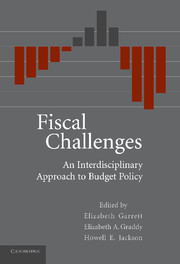Book contents
- Frontmatter
- Contents
- Preface
- Contributors
- PART ONE THE LAW AND POLITICS OF FISCAL POLICY
- PART TWO UNDERSTANDING FEDERAL DEFICITS AND PUBLIC DEBT
- PART THREE BUDGETING AND FISCAL CONSTRAINTS AT THE STATE LEVEL
- PART FOUR INTERGOVERNMENTAL ASPECTS OF BUDGET POLICY
- PART FIVE JUDICIAL POWERS AND BUDGET POLICY
- Index
PART TWO - UNDERSTANDING FEDERAL DEFICITS AND PUBLIC DEBT
Published online by Cambridge University Press: 23 December 2009
- Frontmatter
- Contents
- Preface
- Contributors
- PART ONE THE LAW AND POLITICS OF FISCAL POLICY
- PART TWO UNDERSTANDING FEDERAL DEFICITS AND PUBLIC DEBT
- PART THREE BUDGETING AND FISCAL CONSTRAINTS AT THE STATE LEVEL
- PART FOUR INTERGOVERNMENTAL ASPECTS OF BUDGET POLICY
- PART FIVE JUDICIAL POWERS AND BUDGET POLICY
- Index
Summary
For the general public, the federal deficits and public debt are the most visible and commonly encountered manifestations of budget policy. Newspapers faithfully track the rise and fall of the federal deficits, politicians routinely decry the state of the government's fiscal affairs, and New York's Times Square even features an electronic billboard that tracks the total outstanding federal debt in real time. Notwithstanding the ubiquity of the terms federal deficit and public debt in our national discourse, the meaning and importance of these terms is often obscure. To begin with, the numbers at issue are often astronomical. Annual federal deficits run in the hundreds of billions of dollars; the national debt reaches into the trillions of dollars. And, increasingly, experts have begun to speak in terms of unfunded obligations for entitlement programs that surge into the tens of trillions of dollars. But beyond the difficulty of comprehending the significance of number of this magnitude, there are also complexities in understanding what the federal deficit and public debt actually represent and what levels of deficit and debt would be appropriate for a country such as our own. As we will see, there are many ways to measure federal deficits and debt, and different measurements may be more appropriate in different contexts. The calculation of deficits and debt also has political implications, and so politicians are keenly interested in how these numbers are assembled and reported to the general public.
- Type
- Chapter
- Information
- Fiscal ChallengesAn Interdisciplinary Approach to Budget Policy, pp. 139 - 140Publisher: Cambridge University PressPrint publication year: 2008



